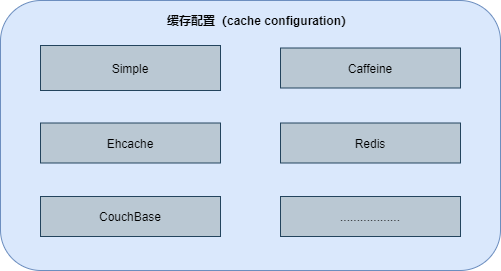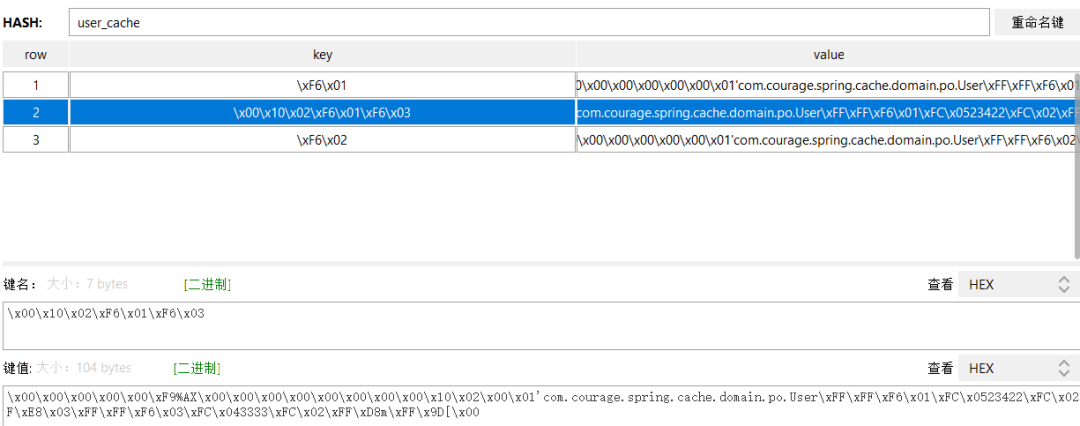- A+

1 硬编码
在学习Spring Cache之前,笔者经常会硬编码的方式使用缓存。
举个例子,为了提升用户信息的查询效率,我们对用户信息使用了缓存,示例代码如下:
@Autowire
private UserMapper userMapper;
@Autowire
private StringCommand stringCommand;
//查询用户
public User getUserById(Long userId) {
String cacheKey = "userId_" + userId;
User user=stringCommand.get(cacheKey);
if(user != null) {
return user;
}
user = userMapper.getUserById(userId);
if(user != null) {
stringCommand.set(cacheKey,user);
return user;
}
//修改用户
public void updateUser(User user){
userMapper.updateUser(user);
String cacheKey = "userId_" + userId.getId();
stringCommand.set(cacheKey , user);
}
//删除用户
public void deleteUserById(Long userId){
userMapper.deleteUserById(userId);
String cacheKey = "userId_" + userId.getId();
stringCommand.del(cacheKey);
}
}
相信很多同学都写过类似风格的代码,这种风格符合面向过程的编程思维,非常容易理解。但它也有一些缺点:
-
代码不够优雅。业务逻辑有四个典型动作:存储,读取,修改,删除。每次操作都需要定义缓存Key ,调用缓存命令的API,产生较多的重复代码;
-
缓存操作和业务逻辑之间的代码耦合度高,对业务逻辑有较强的侵入性。
侵入性主要体现如下两点:
-
开发联调阶段,需要去掉缓存,只能注释或者临时删除缓存操作代码,也容易出错; -
某些场景下,需要更换缓存组件,每个缓存组件有自己的API,更换成本颇高。
2 缓存抽象
首先需要明确一点:Spring Cache不是一个具体的缓存实现方案,而是一个对缓存使用的抽象(Cache Abstraction)。

2.1 Spring AOP
Spring AOP是基于代理模式(proxy-based)。
通常情况下,定义一个对象,调用它的方法的时候,方法是直接被调用的。
Pojo pojo = new SimplePojo();
pojo.foo();

将代码做一些调整,pojo对象的引用修改成代理类。
ProxyFactory factory = new ProxyFactory(new SimplePojo());
factory.addInterface(Pojo.class);
factory.addAdvice(new RetryAdvice());
Pojo pojo = (Pojo) factory.getProxy();
//this is a method call on the proxy!
pojo.foo();

调用pojo的foo方法的时候,实际上是动态生成的代理类调用foo方法。
代理类在方法调用前可以获取方法的参数,当调用方法结束后,可以获取调用该方法的返回值,通过这种方式就可以实现缓存的逻辑。
2.2 缓存声明
缓存声明,也就是标识需要缓存的方法以及缓存策略。
Spring Cache 提供了五个注解。
-
@Cacheable:根据方法的请求参数对其结果进行缓存,下次同样的参数来执行该方法时可以直接从缓存中获取结果,而不需要再次执行该方法; -
@CachePut:根据方法的请求参数对其结果进行缓存,它每次都会触发真实方法的调用; -
@CacheEvict:根据一定的条件删除缓存; -
@Caching:组合多个缓存注解; -
@CacheConfig:类级别共享缓存相关的公共配置。
我们重点讲解:@Cacheable,@CachePut,@CacheEvict三个核心注解。
2.2.1 @Cacheable注解
@Cacheble注解表示这个方法有了缓存的功能。
@Cacheable(value="user_cache",key="#userId", unless="#result == null")
public User getUserById(Long userId) {
User user = userMapper.getUserById(userId);
return user;
}
上面的代码片段里,getUserById方法和缓存user_cache 关联起来,若方法返回的User对象不为空,则缓存起来。第二次相同参数userId调用该方法的时候,直接从缓存中获取数据,并返回。
▍ 缓存key的生成
我们都知道,缓存的本质是key-value存储模式,每一次方法的调用都需要生成相应的Key, 才能操作缓存。
通常情况下,@Cacheable有一个属性key可以直接定义缓存key,开发者可以使用SpEL语言定义key值。
若没有指定属性key,缓存抽象提供了 KeyGenerator来生成key ,默认的生成器代码见下图:
它的算法也很容易理解:
-
如果没有参数,则直接返回SimpleKey.EMPTY; -
如果只有一个参数,则直接返回该参数; -
若有多个参数,则返回包含多个参数的SimpleKey对象。
当然Spring Cache也考虑到需要自定义Key生成方式,需要我们实现org.springframework.cache.interceptor.KeyGenerator 接口。
Object generate(Object target, Method method, Object... params);
然后指定@Cacheable的keyGenerator属性。
@Cacheable(value="user_cache", keyGenerator="myKeyGenerator", unless="#result == null")
public User getUserById(Long userId)
▍ 缓存条件
有的时候,方法执行的结果是否需要缓存,依赖于方法的参数或者方法执行后的返回值。
注解里可以通过condition属性,通过Spel表达式返回的结果是true 还是false 判断是否需要缓存。
@Cacheable(cacheNames="book", condition="#name.length() < 32")
public Book findBook(String name)
上面的代码片段里,当参数的长度小于32,方法执行的结果才会缓存。
除了condition,unless属性也可以决定结果是否缓存,不过是在执行方法后。
@Cacheable(value="user_cache",key="#userId", unless="#result == null")
public User getUserById(Long userId) {
上面的代码片段里,当返回的结果为null则不缓存。
2.2.2 @CachePut注解
@CachePut注解作用于缓存需要被更新的场景,和 @Cacheable 非常相似,但被注解的方法每次都会被执行。
返回值是否会放入缓存,依赖于condition和unless,默认情况下结果会存储到缓存。
@CachePut(value = "user_cache", key="#user.id", unless = "#result != null")
public User updateUser(User user) {
userMapper.updateUser(user);
return user;
}
当调用updateUser方法时,每次方法都会被执行,但是因为unless属性每次都是true,所以并没有将结果缓存。当去掉unless属性,则结果会被缓存。
2.2.3 @CacheEvict注解
@CacheEvict 注解的方法在调用时会从缓存中移除已存储的数据。
@CacheEvict(value = "user_cache", key = "#id")
public void deleteUserById(Long id) {
userMapper.deleteUserById(id);
}
当调用deleteUserById方法完成后,缓存key等于参数id的缓存会被删除,而且方法的返回的类型是Void ,这和@Cacheable明显不同。
2.3 缓存配置
Spring Cache是一个对缓存使用的抽象,它提供了多种存储集成。

要使用它们,需要简单地声明一个适当的CacheManager - 一个控制和管理Cache的实体。
我们以Spring Cache默认的缓存实现Simple例子,简单探索下CacheManager的机制。
CacheManager非常简单:
public interface CacheManager {
@Nullable
Cache getCache(String name);
Collection<String> getCacheNames();
}
在CacheConfigurations配置类中,可以看到不同集成类型有不同的缓存配置类。

通过SpringBoot的自动装配机制,创建CacheManager的实现类ConcurrentMapCacheManager。

而ConcurrentMapCacheManager的getCache方法,会创建ConcurrentCacheMap。

ConcurrentCacheMap实现了org.springframework.cache.Cache接口。

从Spring Cache的Simple的实现,缓存配置需要实现两个接口:
-
org.springframework.cache.CacheManager
-
org.springframework.cache.Cache
3 入门例子
首先我们先创建一个工程spring-cache-demo。

caffeine和Redisson分别是本地内存和分布式缓存Redis框架中的佼佼者,我们分别演示如何集成它们。
3.1 集成caffeine
3.1.1 maven依赖
<dependency>
<groupId>org.springframework.boot</groupId>
<artifactId>spring-boot-starter-cache</artifactId>
</dependency>
<dependency>
<groupId>com.github.ben-manes.caffeine</groupId>
<artifactId>caffeine</artifactId>
<version>2.7.0</version>
</dependency>
3.1.2 Caffeine缓存配置
我们先创建一个缓存配置类MyCacheConfig。
@Configuration
@EnableCaching
public class MyCacheConfig {
@Bean
public Caffeine caffeineConfig() {
return
Caffeine.newBuilder()
.maximumSize(10000).
expireAfterWrite(60, TimeUnit.MINUTES);
}
@Bean
public CacheManager cacheManager(Caffeine caffeine) {
CaffeineCacheManager caffeineCacheManager = new CaffeineCacheManager();
caffeineCacheManager.setCaffeine(caffeine);
return caffeineCacheManager;
}
}
首先创建了一个Caffeine对象,该对象标识本地缓存的最大数量是10000条,每个缓存数据在写入60分钟后失效。
另外,MyCacheConfig类上我们添加了注解:@EnableCaching。
3.1.3 业务代码
根据缓存声明这一节,我们很容易写出如下代码。
@Cacheable(value = "user_cache", unless = "#result == null")
public User getUserById(Long id) {
return userMapper.getUserById(id);
}
@CachePut(value = "user_cache", key = "#user.id", unless = "#result == null")
public User updateUser(User user) {
userMapper.updateUser(user);
return user;
}
@CacheEvict(value = "user_cache", key = "#id")
public void deleteUserById(Long id) {
userMapper.deleteUserById(id);
}
这段代码与硬编码里的代码片段明显精简很多。
当我们在Controller层调用 getUserById方法时,调试的时候,配置mybatis日志级别为DEBUG,方便监控方法是否会缓存。
第一次调用会查询数据库,打印相关日志:
Preparing: select * FROM user t where t.id = ?
Parameters: 1(Long)
Total: 1
第二次调用查询方法的时候,数据库SQL日志就没有出现了, 也就说明缓存生效了。
3.2 集成Redisson
3.2.1 maven依赖
<dependency>
<groupId>org.Redisson</groupId>
<artifactId>Redisson</artifactId>
<version>3.12.0</version>
</dependency>
3.2.2 Redisson缓存配置
@Bean(destroyMethod = "shutdown")
public RedissonClient Redisson() {
Config config = new Config();
config.useSingleServer()
.setAddress("redis://127.0.0.1:6201").setPassword("ts112GpO_ay");
return Redisson.create(config);
}
@Bean
CacheManager cacheManager(RedissonClient RedissonClient) {
Map<String, CacheConfig> config = new HashMap<String, CacheConfig>();
// create "user_cache" spring cache with ttl = 24 minutes and maxIdleTime = 12 minutes
config.put("user_cache",
new CacheConfig(
24 * 60 * 1000,
12 * 60 * 1000));
return new RedissonSpringCacheManager(RedissonClient, config);
}
可以看到,从Caffeine切换到Redisson,只需要修改缓存配置类,定义CacheManager 对象即可。而业务代码并不需要改动。
Controller层调用 getUserById方法,用户ID为1的时候,可以从Redis Desktop Manager里看到:用户信息已被缓存,user_cache缓存存储是Hash数据结构。

因为Redisson默认的编解码是FstCodec, 可以看到key的名称是:\xF6\x01。
在缓存配置代码里,可以修改编解码器。
public RedissonClient Redisson() {
Config config = new Config();
config.useSingleServer()
.setAddress("redis://127.0.0.1:6201").setPassword("ts112GpO_ay");
config.setCodec(new JsonJacksonCodec());
return Redisson.create(config);
}
再次调用 getUserById方法 ,控制台就变成:

可以观察到:缓存key已经变成了:["java.lang.Long",1],改变序列化后key和value已发生了变化。
3.3 从列表缓存再次理解缓存抽象
列表缓存在业务中经常会遇到。通常有两种实现形式:
-
整体列表缓存; -
按照每个条目缓存,通过redis,memcached的聚合查询方法批量获取列表,若缓存没有命中,则从数据库重新加载,并放入缓存里。
那么Spring cache整合Redisson如何缓存列表数据呢?
@Cacheable(value = "user_cache")
public List<User> getUserList(List<Long> idList) {
return userMapper.getUserByIds(idList);
}
执行getUserList方法,参数id列表为:[1,3] 。

执行完成之后,控制台里可以看到:列表整体直接被缓存起来,用户列表缓存和用户条目缓存并没有共享,他们是平行的关系。
这种情况下,缓存的颗粒度控制也没有那么细致。
类似这样的思考,很多开发者也向Spring Framework研发团队提过。


官方的回答也很明确:对于缓存抽象来讲,它并不关心方法返回的数据类型,假如是集合,那么也就意味着需要把集合数据在缓存中保存起来。
还有一位开发者,定义了一个@CollectionCacheable注解,并做出了原型,扩展了Spring Cache的列表缓存功能。
@Cacheable("myCache")
public String findById(String id) {
//access DB backend return item
}
@CollectionCacheable("myCache")
public Map<String, String> findByIds(Collection<String> ids) {
//access DB backend,return map of id to item
}
官方也未采纳,因为缓存抽象并不想引入太多的复杂性。
写到这里,相信大家对缓存抽象有了更进一步的理解。当我们想实现更复杂的缓存功能时,需要对Spring Cache做一定程度的扩展。
4 自定义二级缓存
4.1 应用场景
笔者曾经在原来的项目,高并发场景下多次使用多级缓存。多级缓存是一个非常有趣的功能点,值得我们去扩展。
多级缓存有如下优势:
-
离用户越近,速度越快; -
减少分布式缓存查询频率,降低序列化和反序列化的CPU消耗; -
大幅度减少网络IO以及带宽消耗。
进程内缓存做为一级缓存,分布式缓存做为二级缓存,首先从一级缓存中查询,若能查询到数据则直接返回,否则从二级缓存中查询,若二级缓存中可以查询到数据,则回填到一级缓存中,并返回数据。若二级缓存也查询不到,则从数据源中查询,将结果分别回填到一级缓存,二级缓存中。
 来自《凤凰架构》缓存篇
来自《凤凰架构》缓存篇
Spring Cache并没有二级缓存的实现,我们可以实现一个简易的二级缓存DEMO,加深对技术的理解。
4.2 设计思路
-
MultiLevelCacheManager:多级缓存管理器; -
MultiLevelChannel:封装Caffeine和RedissonClient; -
MultiLevelCache:实现org.springframework.cache.Cache接口; -
MultiLevelCacheConfig:配置缓存过期时间等;
MultiLevelCacheManager是最核心的类,需要实现getCache和getCacheNames两个接口。

创建多级缓存,第一级缓存是:Caffeine , 第二级缓存是:Redisson。

二级缓存,为了快速完成DEMO,我们使用Redisson对Spring Cache的扩展类RedissonCache 。它的底层是RMap,底层存储是Hash。

我们重点看下缓存的「查询」和「存储」的方法:
@Override
public ValueWrapper get(Object key) {
Object result = getRawResult(key);
return toValueWrapper(result);
}
public Object getRawResult(Object key) {
logger.info("从一级缓存查询key:" + key);
Object result = localCache.getIfPresent(key);
if (result != null) {
return result;
}
logger.info("从二级缓存查询key:" + key);
result = RedissonCache.getNativeCache().get(key);
if (result != null) {
localCache.put(key, result);
}
return result;
}
「查询」数据的流程:
-
先从本地缓存中查询数据,若能查询到,直接返回; -
本地缓存查询不到数据,查询分布式缓存,若可以查询出来,回填到本地缓存,并返回; -
若分布式缓存查询不到数据,则默认会执行被注解的方法。
下面来看下「存储」的代码:
public void put(Object key, Object value) {
logger.info("写入一级缓存 key:" + key);
localCache.put(key, value);
logger.info("写入二级缓存 key:" + key);
RedissonCache.put(key, value);
}
最后配置缓存管理器,原有的业务代码不变。

执行下getUserById方法,查询用户编号为1的用户信息。
- 从一级缓存查询key:1
- 从二级缓存查询key:1
- ==> Preparing: select * FROM user t where t.id = ?
- ==> Parameters: 1(Long)
- <== Total: 1
- 写入一级缓存 key:1
- 写入二级缓存 key:1
第二次执行相同的动作,从日志可用看到从优先会从本地内存中查询出结果。
- 从一级缓存查询key:1
等待30s , 再执行一次,因为本地缓存会失效,所以执行的时候会查询二级缓存
- 从一级缓存查询key:1
- 从二级缓存查询key:1
一个简易的二级缓存就组装完了。
5 什么场景选择Spring Cache
在做技术选型的时候,需要针对场景选择不同的技术。
笔者认为Spring Cache的功能很强大,设计也非常优雅。特别适合缓存控制没有那么细致的场景。比如门户首页,偏静态展示页面,榜单等等。这些场景的特点是对数据实时性没有那么严格的要求,只需要将数据源缓存下来,过期之后自动刷新即可。这些场景下,Spring Cache就是神器,能大幅度提升研发效率。
但在高并发大数据量的场景下,精细的缓存颗粒度的控制上,还是需要做功能扩展。
-
多级缓存; -
列表缓存; -
缓存变更监听器;
笔者也在思考这几点的过程,研读了 j2cache , jetcache相关源码,受益匪浅。它们的设计思想很多可以用于扩展Spring Cache。





